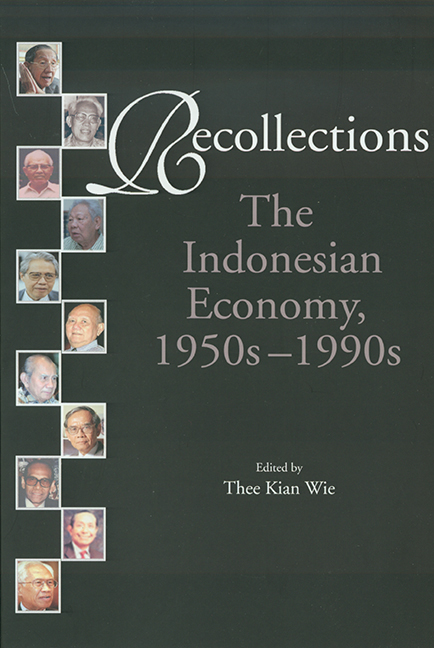Book contents
- Frontmatter
- Dedication
- Contents
- Foreword
- Preface
- Acknowledgments
- Introduction
- II Recollections
- 1 Sumitro Djojohadikusumo
- 2 Mohammad Saubari
- 3 Sjafruddin Prawiranegara
- 4 Abdoel Raoef Soehoed
- 5 Sarbini Sumawinata
- 6 Mohammad Sadli
- 7 Soedarpo Sastrosatomo
- 8 Suhadi Mangkusuwondo
- 9 Emil Salim
- 10 Subroto
- 11 Teuku Mohamad Daud
- Index
- About the Editor
8 - Suhadi Mangkusuwondo
from II - Recollections
Published online by Cambridge University Press: 21 October 2015
- Frontmatter
- Dedication
- Contents
- Foreword
- Preface
- Acknowledgments
- Introduction
- II Recollections
- 1 Sumitro Djojohadikusumo
- 2 Mohammad Saubari
- 3 Sjafruddin Prawiranegara
- 4 Abdoel Raoef Soehoed
- 5 Sarbini Sumawinata
- 6 Mohammad Sadli
- 7 Soedarpo Sastrosatomo
- 8 Suhadi Mangkusuwondo
- 9 Emil Salim
- 10 Subroto
- 11 Teuku Mohamad Daud
- Index
- About the Editor
Summary
YOUTH AND EARLY EDUCATION
I was born in Solo on 27 December 1927, the son of a civil servant with the colonial government's Department of Finance. Having completed primary education at the Dutch Native School (Hollands-Inlandse School, HIS) in Bondowoso, East Java, in 1940, I attended a Dutch high school, the Higher Civilian School (Hogere Burgerschool, HBS) in Malang, where I was one of only two Indonesians among the 40 pupils enrolled in the first grade. The following year the Pacific war broke out, and my parents moved to Bandung.
During the Japanese occupation I attended a Japanese junior high school in Bandung, which gave me the opportunity to learn to speak and read some Japanese, particularly the katakana script. As a result I was able to read Japanese newspapers printed in katakana and hiragana.
THE WAR OF INDEPENDENCE
When the revolution broke out in 1945, young people like me used to listen to Sukarno's speeches, which aroused our revolutionary fervour. Together with my two elder brothers I joined the nationalist independence fighters who took up arms, and later joined the students’ army (TRIP) in Malang. We set out to wrest power from the Japanese by trying to obtain their arms. These actions, however, had sad consequences for our family: the Japanese military raided our house and took away my father. We learned from other people that he was taken to a Japanese prison camp, and we never saw him again.
In the students’ army I was made commander of a company of about 60 men, including a young soldier, Widjojo, who already at that time was considered extremely intelligent by his friends.
The student army was not part of the newly established Tentara Nasional Indonesia, TNI (Indonesia's National Army). We were fighting side by side with the TNI against the Dutch, and were only lightly armed with rifles and a few machine guns and mortars.
- Type
- Chapter
- Information
- RecollectionsThe Indonesian Economy, 1950s–1990s, pp. 165 - 184Publisher: ISEAS–Yusof Ishak InstitutePrint publication year: 2003



